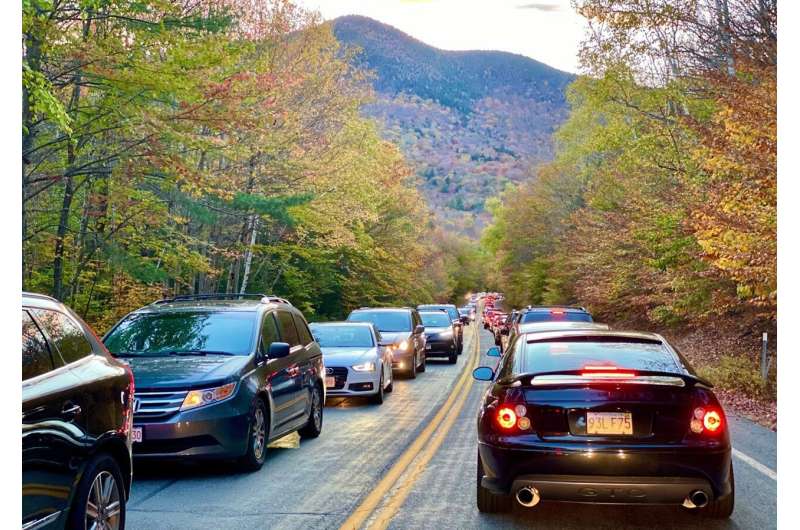Research finds pandemic adversely impacts already stressed national forests

Many human experiences were uniquely altered during the COVID-19 pandemic including a significant rise in the number of people seeking outdoor recreation options during quarantine. In a series of studies looking at this trend, researchers at the University of New Hampshire found a dramatic increase during the pandemic of visitors to the parks and protected areas of New England that resulted in significant social, situational and ecological impacts on people's behavior, decision making and experience quality.
"At the height of the pandemic, in the summer of 2020, outdoor recreation visitation within New England national forests increased by more than 60%, or approximately two million visitors, a majority of which came from out of state," said Michael Ferguson, assistant professor of recreation management and policy. "While it was great to see so many people rediscovering the outdoors and taking advantage of recreation opportunities, it also raised questions and concerns about these already overwhelmed natural resources."
The extensive suite of research, which includes a study recently published in the journal Society and Natural Resources, assesses the status of the so-called outdoor renaissance at the peak of the pandemic by examining visitation increases and shifts in behavior and decision making at the White Mountain National Forest and the Green Mountain National Forest. While the pandemic fueled visitation issues, these national forests were already seeing significant problems as early as 2017, including social (crowding and conflict), situational (site access and litter) and ecological (snowpack and ticks). During the summer of 2020, resource managers at the White Mountain National Forest commissioned the researchers to take a closer look at these concerns. The results of this study, published in the Journal of Outdoor Recreation and Tourism, found never-before-seen visitation numbers resulting in even more pervasive recreation challenges including long traffic lines, lack of parking, trail congestion and unprecedented instances of overcrowding and discord.
However, researchers found for the most part, visitors were largely able to cope and deal with most of the situations they encountered, but the one factor that was consistently difficult for them to tolerate was visitor conflict. This included arguments or disagreements, mostly between in-state and out-of-state visitors, largely based on perceived violations of pandemic safety protocols like not wearing masks or honoring physical distancing.
"Our data and modeling suggest that approximately 10% of annual visitation, which represents nearly 400,000 visitors, noted they would likely never return for outdoor recreation because of the issues they experienced," said Ferguson.
To validate these initial findings, the researchers took a deeper dive into the impact of the pandemic on outdoor recreation visitors, with a specific focus on historically marginalized populations. This paper, published in the Journal of Outdoor Recreation and Tourism, confirmed the huge surge in national forest visitation during the pandemic and explored the significant increase in adverse interactions. The researchers also found that historically marginalized populations stated unique hurdles. For instance, low income visitors reported significantly less substitution options as opposed to high income visitors and female visitors reported significantly higher instances of conflict during the pandemic.
"COVID-19 unleashed a phenomenon that we didn't anticipate," said Ferguson. "It really changed the outdoor recreation experience and the manner in which these resources and experiences must be managed."
Researchers say more studies are needed to determine next steps but hope this extensive research will help pinpoint continued issues and improve the decision-making process for resource managers, elected officials and visitors. The study team also noted that many parks and protected areas across the country experienced similar issues and moved to managed access systems to combat increasing visitation. Researchers are hopeful that future studies will help determine the best solutions for the New England national forest system.
More information: Michael D. Ferguson et al, The Outdoor Renaissance: Assessing the Impact of the COVID-19 Pandemic upon Outdoor Recreation Visitation, Behaviors, and Decision-Making in New England's National Forests, Society & Natural Resources (2022). DOI: 10.1080/08941920.2022.2055247
Michael D. Ferguson et al, The nature of the pandemic: Exploring the negative impacts of the COVID-19 pandemic upon recreation visitor behaviors and experiences in parks and protected areas, Journal of Outdoor Recreation and Tourism (2022). DOI: 10.1016/j.jort.2022.100498
Provided by University of New Hampshire


















